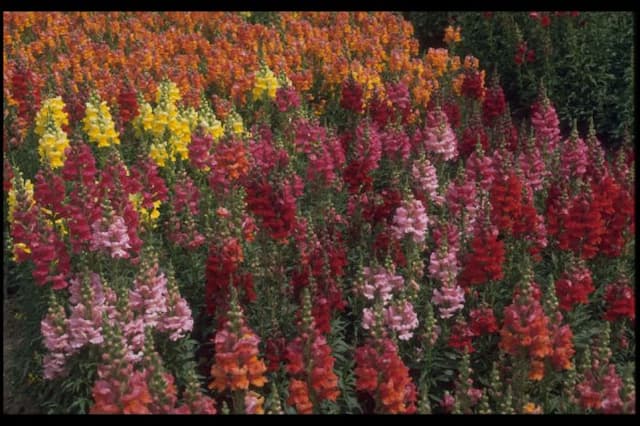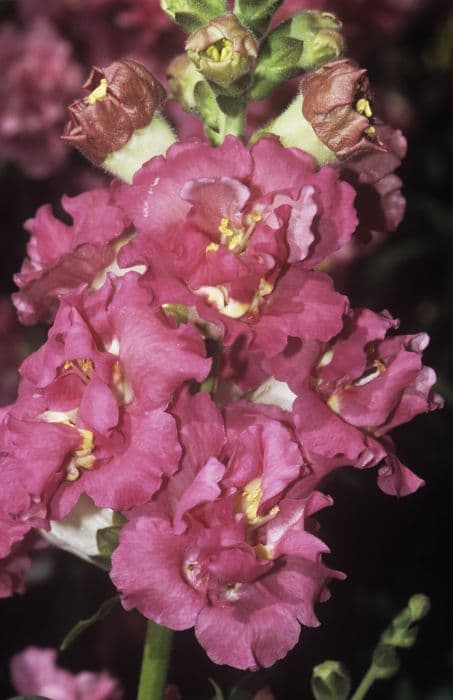Isophyllus Penstemon Penstemon isophyllus

ABOUT
Penstemon isophyllus, also known as the isophyllus beardtongue, is a perennial plant that features an attractive foliage complemented with striking flowers. The leaves of the isophyllus beardtongue are usually arranged in an opposite manner along the stems, creating a sense of symmetry and order. Their color can be described as a deep green, providing a lush backdrop for the blossoms. The flowers of this plant are what draw the most attention. They tend to appear in clusters, known as inflorescences, and each individual bloom resembles a tubular shape. The petals of the flowers flare outwards at the mouth, somewhat reminiscent of an open bell or a trumpet. This characteristic shape is quite appealing to a variety of pollinators. Usually, the blossoms come in vibrant color tones that can range from pink to purple shades, occasionally with streaks or spots of contrasting colors adding to their ornamental value. They possess a delicate charm, thanks to the fine lines and subtle gradations of color that are often present on the petals. These flowers, set against the foliage, create a captivating visual display that is often used to add a touch of natural beauty to gardens and landscapes. The isophyllus beardtongue has a growth habit that allows it to form clumps or masses of foliage and flowers, culminating in a lush appearance. It's important to note that while describing the appearance of the plant, the specific dimensions are intentionally omitted from this description.
About this plant
 Names
NamesFamily
Plantaginaceae
Synonyms
Panamint Beardtongue
Common names
Penstemon isophyllus
 Toxicity
ToxicityTo humans
Penstemon, also known as beardtongue, is not commonly known to be toxic to humans. There are no well-documented cases of poisoning from Penstemon isophyllus, and it is generally considered safe around humans. As with any plant, individual allergies or sensitivities could exist, so it is always wise to be cautious when handling or possibly ingesting parts of any plant. If any part of the plant is ingested and symptoms of an allergic reaction or poisoning appear, medical attention should be sought.
To pets
Penstemon, also known as beardtongue, is not commonly known to be toxic to pets either. There are no well-documented cases of pet poisoning involving ingestion of Penstemon isophyllus. It is generally considered to be a plant that does not pose a significant risk to dogs, cats, or other household pets. Despite its low toxicity, it is always prudent to monitor pets around plants and prevent them from ingesting large amounts of foliage or flowers, as gastrointestinal upset or an allergic reaction could possibly occur. If a pet shows any signs of distress after ingesting any part of the plant, consultation with a veterinarian would be advised.
 Characteristics
CharacteristicsLife cycle
Perennials
Foliage type
Evergreen
Color of leaves
Green
Flower color
Pink
Height
2 feet (0.61 meters)
Spread
2 feet (0.61 meters)
Plant type
Herb
Hardiness zones
8
Native area
Mexico
Benefits
 General Benefits
General Benefits- Attracts Pollinators: Penstemon isophyllus is known to attract bees, butterflies, and hummingbirds, which are beneficial for pollination in gardens.
- Drought Tolerance: Once established, this plant has a good resistance to drought, making it suitable for water-wise gardens.
- Ornamental Value: With its showy flowers, the Penstemon isophyllus adds aesthetic appeal to gardens and landscapes.
- Erosion Control: It can help stabilize soil and prevent erosion on slopes due to its root structure.
- Low Maintenance: This plant generally requires minimal care once established, making it a good choice for low-maintenance landscapes.
- Habitat Creation: Provides food and shelter for various insects, which are important components of a healthy ecosystem.
- Seasonal Interest: It has a long flowering season, offering visual interest for much of the growing season.
- Adaptability: Penstemon isophyllus can adapt to various soil types, although it prefers well-drained soils.
- Native Plant Benefits: Being native to certain regions, it can be particularly beneficial for maintaining local biodiversity.
 Medical Properties
Medical PropertiesThis plant is not used for medical purposes.
 Air-purifying Qualities
Air-purifying QualitiesThis plant is not specifically known for air purifying qualities.
 Other Uses
Other Uses- Artistic Inspiration: Penstemon isophyllus, also known as foothill penstemon, can serve as an artistic muse for painters and photographers, capturing its vivid colors and unique form.
- Educational Tool: With its distinctive morphology, foothill penstemon can be used in botany classes for students to learn about plant structure and pollination strategies.
- Habitat Restoration: This plant can be used in native plant gardens and restoration projects to promote biodiversity and support local wildlife.
- Garden Aesthetics: This species adds visual interest to rock gardens and xeriscapes with its sprawling habit and tubular flowers.
- Soil Stabilization: Foothill penstemon can help prevent soil erosion on slopes due to its root system that holds the soil in place.
- Theme Gardens: This plant can be incorporated into pollinator-friendly gardens to provide nectar for bees, hummingbirds, and butterflies.
- Seasonal Interest: With its vibrant blooms, foothill penstemon is effective for creating seasonal interest in the garden, particularly in spring and summer.
- Floral Arrangements: The cut flowers of foothill penstemon can be used in fresh bouquets for a natural and wildflower look.
- Bonsai: The foothill penstemon can potentially be grown as a bonsai, offering a unique challenge to enthusiasts of this art form.
- Culinary Presentations: Although not for consumption, the flowers can be used as ornate, non-toxic garnishes for salads and desserts to enhance presentation.
Interesting Facts
 Feng Shui
Feng ShuiThe Penstemon is not used in Feng Shui practice.
 Zodiac Sign Compitability
Zodiac Sign CompitabilityThe Penstemon is not used in astrology practice.
 Plant Symbolism
Plant Symbolism- Attraction and Charm: The striking flowers of the Twinning Penstemon often symbolize attraction and charm, reflecting their eye-catching appearance that attracts pollinators and human admiration alike.
- Endurance and Strength: As a plant that can thrive in challenging environments, the Twinning Penstemon is often associated with endurance and the strength to persevere through difficulties.
- Diversity and Adaptability: With the variety of colors and shapes found in the Penstemon genus, the Twinning Penstemon can represent diversity and adaptability, celebrating the ability to flourish in a wide range of conditions.
 Water
WaterFor a tidy beardtongue (Penstemon isophyllus), water it weekly during its growing season, using enough water to moisten the soil to a depth of several inches, which might be about 1 gallon for an average-sized plant. Reduce watering to every other week during cooler months when the plant is not actively growing, always checking the soil moisture before watering. Ensure that the plant is placed in well-draining soil to prevent waterlogging. During hot, dry spells, you may need to water more frequently, while in periods of rain, reduce the amount of supplemental water provided.
 Light
LightThe tidy beardtongue thrives best in full sun to partial shade, meaning it should receive at least 6 hours of sunlight daily. Place the plant in a location where it is exposed to morning sunlight but protected from the intense heat of the late afternoon sun, especially in hotter climates.
 Temperature
TemperatureTidy beardtongue prefers temperatures between 50°F and 85°F but can survive in temperatures as low as 20°F for short periods. Avoid exposing the plant to prolonged temperatures below freezing to prevent damage. The ideal temperature range for flourishing growth is between 60°F and 70°F.
 Pruning
PruningPrune the tidy beardtongue to remove spent flowers and encourage a second bloom in late summer or early fall. Cut back the entire plant by about a third after the first flowering period to keep it compact and to promote healthy new growth. The best time for major pruning is in late winter or early spring before new growth starts.
 Cleaning
CleaningAs needed
 Soil
SoilThe best soil mix for the Beardtongue (Penstemon isophyllus) includes a mixture of loam, sand, and compost to ensure good drainage and aeration. The ideal soil pH for Penstemon isophyllus is slightly acidic to neutral, ranging between 6.0 and 7.0. To replicate the plant's native habitat, incorporating some gravel can also be beneficial for drainage.
 Repotting
RepottingBeardtongue (Penstemon isophyllus) should generally be repotted every 2 to 3 years to refresh the soil and provide room for growth. The best time to repot this plant is in the spring just before the onset of the growing season.
 Humidity & Misting
Humidity & MistingBeardtongue (Penstemon isophyllus) prefers moderate humidity levels. It is adaptable and can tolerate some dry air, however, if the air is too dry, a light misting can be beneficial. Avoid excessive humidity which may lead to fungal issues.
 Suitable locations
Suitable locationsIndoor
Place Beardtongue in bright indirect light indoors with well-draining soil mix.
Outdoor
Ensure full sun to partial shade and well-draining soil for outdoor Beardtongue.
Hardiness zone
6-9 USDA
 Life cycle
Life cyclePenstemon isophyllus, commonly known as the Isophyllus Beardtongue, begins its life cycle as a seed, which germinates in the spring when the soil temperature and moisture levels are suitable. The seedlings emerge and develop into juvenile plants with a rosette of leaves at the soil surface. As it matures, Isophyllus Beardtongue grows erect stems and by the second year, it typically produces its distinctive tubular flowers, which are attractive to pollinators, leading to cross-pollination. After pollination, the flowers develop into seed capsules containing numerous small seeds, which are then dispersed by wind or animal movement. The parent plant may die after seed production, completing its lifecycle, but it can also survive through the season to produce flowers and seeds in subsequent years. In colder climates or unfavorable conditions, Isophyllus Beardtongue may behave as a short-lived perennial, re-emerging from its root system to bloom again.
 Propogation
PropogationPropogation time
Spring to Summer
Penstemon isophyllus, commonly known as the Penstemon, is best propagated through stem cuttings, which can be done in late spring to early summer when the plant's growth is most active. To propagate via stem cuttings, select a healthy, non-flowering stem and cut a 4 to 6-inch (10 to 15 cm) section. Strip the leaves from the lower half of the cutting and dip the cut end in rooting hormone powder to encourage root growth. Plant the cutting in a well-draining potting mix, covering the leafless portion. Keep the soil consistently moist but not waterlogged and place the cutting in a bright area without direct sunlight until roots have established, which usually takes a few weeks.





![Snapdragon [Pretty in Pink]](/_next/image?url=https%3A%2F%2Fplants-admin.emdemapps.com%2Fimages%2Fplants%2F%2Fimages%2F604b5cb3b5385.png&w=640&q=75)



